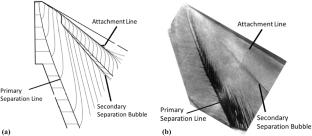Relationship between secondary separation and surface pressure structure in swept shock-wave/boundary-layer interaction
Abstract
A theoretical analysis is presented to elucidate the relationship between the skin friction topology of the secondary separation bubble and surface pressure structure in the fin-generated swept shock-wave/boundary-layer interaction. This theoretical method is based on the intrinsic relation between skin friction and surface pressure, and the variational method is applied to extract skin friction fields when the boundary enstrophy flux is modeled. The skin friction topology extracted from a surface pressure field in swept shock-wave/boundary-layer interaction is studied as the relevant parameters to surface pressure vary. It is found that the formation of the secondary separation bubble characterized as a topological change of skin friction is directly related to the geometrical features of the surface pressure plateau. The extracted skin friction topology of the secondary separation bubble is compared with computational fluid dynamics results and surface oil visualizations in two examples. The developed method provides a useful tool for understanding of complex flow structures in shock-wave/boundary-layer interactions particularly in pressure-sensitive paint measurements.


 求助内容:
求助内容: 应助结果提醒方式:
应助结果提醒方式:


